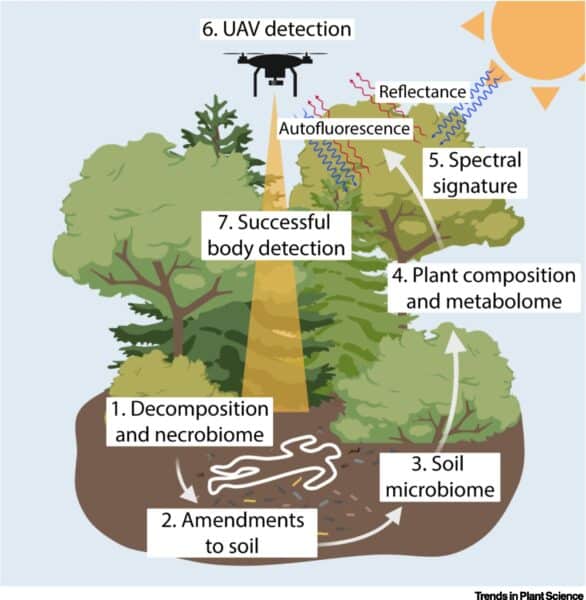Scientists are designing experiments to find out.
This article demonstrates applications of Biology, Chemistry, Physics and Earth Science understanding to develop technology and aid society. It it suitable for year 7-10 students learning about the electromagnetic spectrum, the nitrogen cycle, or ecosystems.
Word Count: 492

This is still quite a way from reality, but the whole idea is too intriguing to ignore.
A collaborative team of forensic botanists, anthropologists and soil scientists in the US is designing its first set of plant-cadaver experiments to see whether it’s feasible for the former to help find the latter.
Search teams looking for human remains, whether on foot or from the air, are often hampered by forest cover. The picture would change, however, in they could use changes in the plants’ chemistry as signals of nearby human remains.
The impact of human decomposition on plants has not yet been thoroughly explored but, in a paper in the journal Trends in Plant Science, researchers from the University of Tennessee have set out the steps needed to make body recovery using vegetation a reality.
The research will take place at the university’s Anthropology Research Facility, where scientists examine the process of human body decay under different conditions.
Neal Stewart Jr and colleagues will assess how “cadaver decomposition islands” – the zones immediately surrounding human remains – change the nutrient concentrations of the soil, and how those changes manifest in the nearby plants.
“The most obvious result of the islands would be a large release of nitrogen into the soil, especially in the summertime when decomposition is happening so fast,” Stewart says. “Depending on how quickly the plants respond to the influx of nitrogen, it may cause changes in leaf colour and reflectance.”
One hurdle is that other mammals live and die in the forest, so the process will have to be able to find metabolites specific to the breakdown of humans. One advantage is that humans typically have non-wild diets.
It may even be possible – those this is squarely in the “long way down the track” category – to look for chemical profiles specific to a missing individual; being a heavy smoker, for example.
The dream is to be able to develop imagers to scan plants for specific fluorescence or reflectance signals that indicate human remains are close by. While some of this technology already exists, Stewart says, scientists still need to know exactly what to look for.
“We’ve actually built a whole plant imager that can analyse fluorescence signatures, but the first steps are going to be very fine scale, looking at individual leaves and measuring how their reflectance or fluorescence changes over time when plants are near human remains.”
If and when diagnostic spectra are compiled, researchers can begin to think about scaling up to drones and other devices that can analyse a wide stretch of area in a short time.
“When you start to think about deploying drones to look for specific emissions, now we can think of the signals more like a check engine light; if we can quickly fly where someone may have gone missing and collect data over tens or even hundreds of square kilometres, then we’d know the best spots to send in a search team,” Stewart says.
Login or Sign up for FREE to download a copy of the full teacher resource






